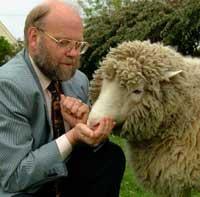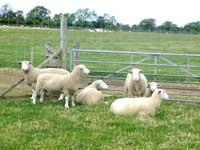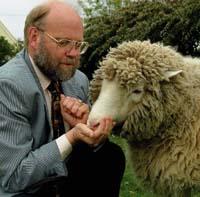Dolly, symbol of cloning ten years
2007/03/25 Rementeria Argote, Nagore - Elhuyar Zientziaren Komunikazioa

Dolly and his father, the researcher of the Roslin Ian Wilmut Institute.
In retrospect, Dolly was born in July 1996 at the Roslin Institute in Scotland, but it wasn't until February 27, 1997 when she noticed it: The news was published in the journal Nature and on the cover appeared the image of the lamb Dolly. The revolt created by that news was huge. In fact, it was the first time that cloning was successfully performed from the cells of an adult mammal. Many thought that if this could be followed, human cloning could be achieved from one day to the next, and that is why most countries drafted contrary laws.
Also frauds

It seems that the risk of human cloning was not for so much. Ten years later, they have not yet managed to clone the man, which we know. There have been efforts and recently they said they had managed to clone the human embryo, but without letting it develop. However, in the media there have been disturbances in this regard, since more than one has claimed human cloning. So did the Rael sect, and it was also the case of Korean Hwang Woo-Suk.
Hwang Woo-Suk was a renowned researcher. Among other things, he managed to clone a dog (Snuppy) and claimed that the man was also meritorious. The journal Science published a story, but raised great doubts among experts. They studied Korean work and saw it as a fraud. This account gave a long-term speech topic.
Of course, in these years the subject of human cloning has been fashionable. At first, people were afraid to do what was science fiction: some imagined armies of clones, others the key to the eternal life of the egolatras and ambitious. But over time it has been clearly seen that cloning has little to do with science fiction.

Clones are not exactly the same when cloned. They are genetically equal, but since the development of the embryo the medium has a great influence on all beings and, therefore, although genetically they are equal, there are no two equal beings.
Now, 10 years later
However, and despite the debate and fears, human cloning is forbidden. Some believed that people with problems to be children would ask for cloning as a reproductive solution, but it has not been so much less. Yes, therapeutic cloning is allowed in many villages. It is a cloning with the aim of curing diseases and, in short, the same technique that was used to clone to Dolly, but to obtain stem cells with human embryos. Therefore, cloning is not totally prohibited either.
Therefore, today the ethical debate par excellence is not human cloning, whether or not. The issue has not been clarified, but the debate has evolved and the oral pleitos are therapeutic cloning and the amena cell.
Published in 7K.

Gai honi buruzko eduki gehiago
Elhuyarrek garatutako teknologia





